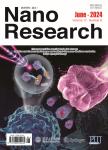Tuning the near room temperature oxidation behavior of highentropy alloy nanoparticles
作者机构:Center of Electron Microscopy and State Key Laboratory of Silicon MaterialsSchool of Materials Science and EngineeringZhejiang UniversityHangzhou 310027China Center for Alloy Innovation and DesignState Key Laboratory for Mechanical Behavior of MaterialsXi'an Jiaotong UniversityXi'an 710049China Woodruff School of Mechanical EngineeringGeorgia Institute of TechnologyAtlantaGA 30332USA
出 版 物:《Nano Research》 (纳米研究(英文版))
年 卷 期:2022年第15卷第4期
页 面:3569-3574页
核心收录:
学科分类:08[工学] 0804[工学-仪器科学与技术] 0805[工学-材料科学与工程(可授工学、理学学位)] 080502[工学-材料学] 0703[理学-化学] 0802[工学-机械工程]
基 金:Q.Y.was supported by the Chinese 1000-Youth-Talent Plan,111 project under(No.B16042),the National Natural Science Foundation of China(No.51671168) the National Basic Research Program of China(No.2015CB65930) J.D.acknowledges support from the Chinese 1000-Youth-Talent Plan and National Natural Science Foundation of China(12004294) The authors acknowledge the support by the HPC platform of Xi’an Jiaotong University.
主 题:In situ transmission electron microscopy(TEM) high-entropy alloy(HEA)nanoparticles(NPs) oxidation
摘 要:Understanding the oxidation behavior of high-entropy alloys(HEAs)is essential to their practical applications.Here we conducted in situ environmental transmission electron microscopy(E-TEM)observations of dynamic oxidation processes in CrMnFeCoNi and CrFeCoNiPd nanoparticles(NPs)near room temperature.During the oxidation of CrMnFeCoNi NPs,a favorable oxidation product was MnCr_(2)O_(4)with the spinel structure.The surface nanoislands of MnCr_(2)O_(4)underwent dynamic reconstruction,resulting in the thickened oxide layer with less crystallinity.In CrFeCoNiPd NPs,the reactive element Mn was replaced by the inert element Pd.As a result,a favorable oxide product was CrO_(2)with the rutile structure.CrO_(2)formed on the NP surface and was a result of Cr outward diffusion through the oxide layer.In addition,FeO nanocrystals formed at the oxide/metal interface and were a result of O inward diffusion through the oxide layer.We also performed first principles calculations to provide insights into the energetics and diffusion rates related to oxide formation.These results reveal the non-equilibrium processes of oxidation in HEA NPs that can be strongly influenced by small particle sizes and large surface areas.This work underscores the high tunability of oxidation behavior in nanoscale HEAs by changing their constituent alloying elements.



